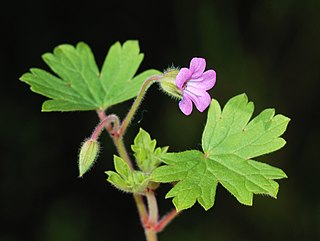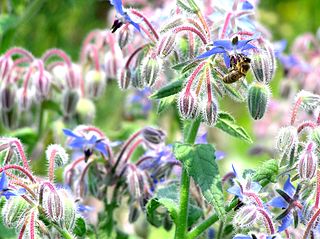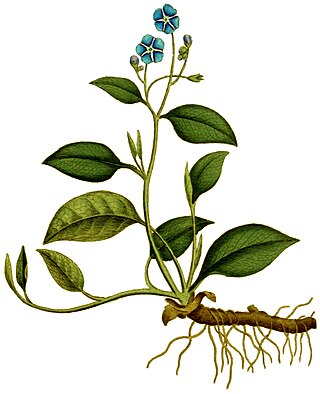
Boraginaceae, the borage or forget-me-notfamily, includes about 2,000 species of shrubs, trees, and herbs in 146 to 154 genera with a worldwide distribution.

Geraniales is a small order of flowering plants, included within the rosid subclade of eudicots. The largest family in the order is Geraniaceae with over 800 species. In addition, the order includes the smaller Francoaceae with about 40 species. Most Geraniales are herbaceous, but there are also shrubs and small trees.

Geraniaceae is a family of flowering plants placed in the order Geraniales. The family name is derived from the genus Geranium. The family includes both the genus Geranium and the garden plants called geraniums, which modern botany classifies as genus Pelargonium, along with other related genera.

Pulmonaria (lungwort) is a genus of flowering plants in the family Boraginaceae, native to Europe and western Asia, with one species east to central Asia. According to various estimates there may be between 10 and 18 species found in the wild.

Phacelia is a genus of about 200 species of annual or perennial herbaceous plants in the borage family, native to North and South America. California is particularly rich in species with over 90 recorded in the region.

Boraginales is an order of flowering plants in the asterid clade, with a total of about 125 genera and 2,700 species. Different taxonomic treatments either include only a single family, the Boraginaceae, or divide it into up to eleven families. Its herbs, shrubs, trees and lianas (vines) have a worldwide distribution.

Myosotidium is a genus of plants belonging to the family Boraginaceae. This genus is represented by the single species Myosotidium hortensia, the Chatham Islands lily, giant forget-me-not or Chatham Islands forget-me-not, which is endemic to the Chatham Islands, New Zealand. In the Māori language, it is known by the name kopukapuka.
Hoplestigma is a genus of flowering plants in the family Boraginaceae, although this is disputed, and it has been placed in its own family Hoplestigmataceae. Its two species are native to Cameroon, Gabon, Ivory Coast and Liberia in western tropical Africa.

Boraginoideae is a subfamily of the plant family Boraginaceae s.s, with about 42 genera. That family is defined in a much broader sense in the Angiosperm Phylogeny Group (APG) system of classification for flowering plants. The APG has not specified any subfamilial structure within Boraginaceae s.l.

Omphalodes (navelwort) is a genus of flowering plants in the family Boraginaceae. It includes eleven species native to Europe and western Asia. In spring they produce blue or white flowers similar to forget-me-nots.

Codon is a small genus of plants from South Africa in the family Codonaceae in the order Boraginales. The genus Codon comprises two species.
Heliotropiaceae are a cosmopolitan family of flowering plants with approximately 450 species worldwide, though it is concentrated especially in the tropics and subtropics.

Pseudomertensia is a genus of flowering plants in the family Boraginaceae. They are perennial herbs with blue or bluish purple flowers. Their natural range is from Iran to the Himalayas. None have been found in China or Russia. P. echioides, and the type species for the genus, P. elongata, are occasionally cultivated as ornamentals.

Coldenia, named after C. Colden, is a monotypic genus of flowering plants traditionally included in the borage family, Boraginaceae sensu lato. It was assigned to the subfamily Ehretioideae, but molecular data revealed it to be more closely related to the genus Cordia, so that other authors placed in Cordioideae. Subsequently, it was placed in its own family, Coldeniaceae, within the Boraginales order, by the Boraginales Working Group.
Mimophytum is a genus of flowering plants in the family Boraginaceae. The species are native to northeastern Mexico and adjacent areas of Texas, United States. They are similar to the closely related genus Omphalodes but a distinct group.

Andersonglossum boreale, known as northern wild comfrey or just wild comfrey, is a species of flowering plant in the borage family, Boraginaceae. It is native to boreal coniferous and mixed forests in North America, from Nova Scotia to British Columbia and Yukon in Canada, south to New Jersey and Indiana in the United States. It is often found in rocky or sandy soils. It is extirpated from many of the southern parts of its range.

Huynhia is a genus of flowering plants belonging to the family Boraginaceae, from Asia.

Greeneocharis is a genus of flowering plants in the family Boraginaceae. There are two species, and it has a disjunct distribution in the western United States and northwestern Mexico in North America and western Argentina in southern South America. It is part of subtribe of Amsinckiinae.
Malesherbia laraosensis is a member of Malesherbia (Passifloraceae) described in 2014 by Hamilton Beltran and Maximilian Weigend. It is the only member of the genus known to inhabit Laraos, Peru. It is described as a small shrub, with branch lengths up to 15 cm long, these features make it morphologically distinct from other Peruvian members of the genus. It has orange flowers with red tips, and flowers from May - July.















